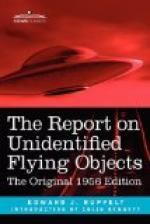Our panel of experts was to consist of six or eight of the top scientists in the United States. We fully realized that even the Air Force didn’t have enough “pull” just to ask all of these people to drop the important work they were engaged in and spend a week or two studying our reports. Nor did we want to do it this way; we wanted to be sure that we had something worth while before asking for their valuable time. So, working through other government agencies, we organized a preliminary review panel of four people. All of them were competent scientists and we knew their reputations were such that if they recommended that a certain top scientist sit on a panel to review our material he would do it.
In late November 1952 the preliminary review panel met at ATIC for three days.
When the meeting ended, the group unanimously recommended that a “higher court” be formed to review the case of the UFO. In an hour their recommendation was accepted by higher Air Force authorities, and the men proceeded to recommend the members for our proposed panel. They picked six men who had reputations as being both practical and theoretical scientists and who were known to have no biased opinions regarding the UFO’s.
The meeting of the panel, which would be held in Washington, was tentatively scheduled for late December or early January—depending upon when all of the scientists who had been asked to attend would be free. At Project Blue Book activity went into high gear as we made preparations for the meeting. But before we were very far along our preparations were temporarily sidetracked—I got a lead on the facts behind a rumor. Normally we didn’t pay attention to rumors, but this one was in a different class.
Ever since the Air Force had become interested in UFO reports, the comment of those who had been requested to look them over and give a professional opinion was that we lacked the type of data “you could get your teeth into.” In even our best reports we had to rely upon what someone had seen. I’d been told many times that if we had even one piece of information that was substantiated by some kind of recorded proof—a set of cinetheodolite movies of a UFO, a spectrum photograph, or any other kind of instrumented data that one could sit down and study—we would have no difficulty getting almost any scientist in the world interested in actively helping us find the answer to the UFO riddle.
The rumor that caused me to temporarily halt our preparations for the high-level conference involved data that we might be able to get our teeth into.
This is the way it went.
In the fall of 1949, at some unspecified place in the United States, a group of scientists had set up equipment to measure background radiation, the small amount of harmless radiation that is always present in our atmosphere. This natural radiation varies to a certain degree, but will never increase by any appreciable amount unless there is a good reason.




